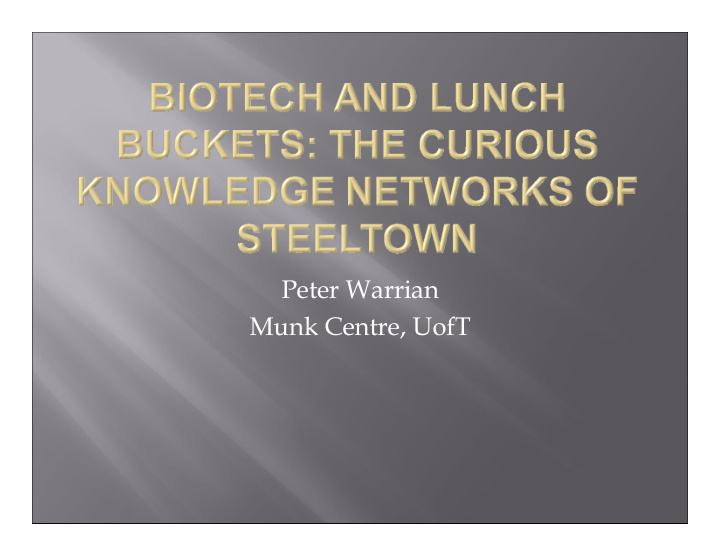



Peter Warrian Munk Centre, UofT
Steel: Stelco Coil Box • – Revolutionized quality control of sheet steel for advanced auto applications Health: Evidence-Based Medicine • – Global standard for clinical practice and health policy
� Hamilton is The Industrial City in Canada � Material backbone of Canadian Manufacturing � It is to Canada what Pittsburgh is to USA � But, it is not Pittsburgh � Pittsburgh Mills 7 to 0 � Hamilton 2 to 2 � Hamilton mills now integrated into Global Steel industry
� Don’t have Companies or Industry as Before � Knowledge Networks � Supply Chains � Object of analysis and policy intervention
� Supply Chains are contested terrain (Sturgeon 2008; Rutherford 2008) � Stelco-US Steel : Branch Plant � Dofasco-Arcelor: Strategic Asset � Knowledge networks frame the configuration of local capabilities within Global Production Networks (Cooke 2005, 2007)
� East: Old Economy – Steel Manufacturing � West: New Economy – University, Health Sciences � Convergence & Interaction � McMaster Medical School Model � Union agreements provide market for new services � Governance: Multi-location, Capital, Union � Demand Side not Supply Side of Labour Market Institutions
� Steel 1 National Steel � Stelco dominant firm � Indigenous Technology Development � Local Customer Base � Steel 2 NAFTA Steel � Dofasco dominant firm � Technology Licensing � Continental Customer Base � Steel 3 Global Steel Production Network
We understand how to weld these parts better than other people do – we have a reputation for running systems that work and we control the technology from software to hardware, everything is done by us. We develop mainly in consultation with customers. We have our own IP based on what we see in the market and we get it by talking to customers, going to trade shows, seeing what the competition has, talking to key people in the industry to see what they want to see. The university has some programmes that we fund but they’re more long term, knowledge for the benefit of the university rather than knowledge we are depending on for tomorrow. Welding Technology CEO
Steel 1 Steel 2 Steel 3 Anchor Firm Stelco Dofasco Arcelor Market Orientation Local Continental Global Bridging Mechanism Proprietary Private Consortia Open Source Exploratory Knowledge In-house Licensed Public infrastructure Exploitative Knowledge Individual customers Regional Global Supply Chains
� Innovative Firms � Health Services � NOT Biotech, Pharmatech � McMaster Teaching Model � Clinical Practice vs Bio-Science � Evidence Based Medicine � Different Relationship to Community Health produces a Different Innovation Dynamic
The McMaster Teaching Model is a good thing. The opportunity there is not as recognized as MaRS. A lot of it is social networking e.g. MySpace. Opportunities that come out of service models and knowledge networks are not just technology plays. It is not just a high profit venture model. Innovators may be not-for-profit, innovating for a new social context, social networking and social oriented technologies. There are different types of technologies coming out of McMaster. For example, current HHS is working on techno-logistics for patient management in hospitals of pre/post- operative pain. Biotech Network Manager
Global/ Local Knowledge Networks � � Steel 1: Stelco’s traditional indigenous research efforts � Steel 2: Dofasco’s technology transfer strategy � Steel 3 Mills Directly integrated into Global Steel Production Network � Universities � McMaster lagged Carnegie-Mellon � Now trying to catchup via Arcelor Mittal & Canmet
� Knowledge Spillovers: Specialization /General � Literature focus on net flows of human resources from old to new economy � Unique to Hamilton is the impact of unions and old economy labour market institutions on the demand side � Hamilton Health Sciences is the source of ideas. It is union agreements that are enabling innovation to be actually implemented
� Role of Public Research Infrastructure � New globalization phase of steel (biotech, fiber optics) � Emergence of asymmetric knowledge networks � Innovation in the future will be non-linear and come from multiple centres of knowledge generation, with each specializing in different aspects of development
Recommend
More recommend